CAA News Today
Africa at the Quai Branly Museum and the Mohammed VI Museum for Modern and Contemporary Art: Challenges for Exhibitions of African Art
posted by CAA — Nov 16, 2017
Colette Apelian, an art historian based in Rabat, Morocco and Los Angeles, California, was invited to submit the following article by Pearlie Rose S. Baluyut, a member of CAA’s International Committee. Apelian holds a PhD in art and architectural history and an MA in Islamic studies from UCLA.
Do museums fail visitors and benefactors when they allow the use of objects to present what many might consider selective histories and definitions of identities? The answer may well be yes, a response that struck me after I visited Picasso Primitive or Primitive Picasso (Picasso Primitif) at the Quai Branly Museum (Musée du Quai Branly; MQB) in Paris, France (March 28–July 23, 2017) and Africa in the Capital City (L’Afrique en Capitale) at the Mohammed VI Museum for Modern and Contemporary Art (Musée Mohammed VI d’Art Moderne et Contemporain; MMVI) in Rabat, Morocco (March 28–July 31, 2017).
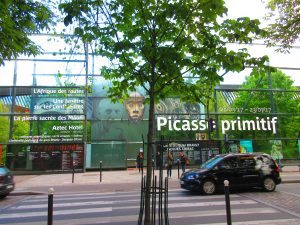
Quai Branly Museum façade. Photo by author.
At the MQB, what can be described as Pablo Picasso’s peccadillos were vaulted as examples of artistic genius and the result of his contact with African artifacts. As visitors walked through the exhibition, they could see Picasso’s art and writings, or reproductions thereof, juxtaposed with African masks, sculptures, and seminude postcard representations of Malinke and Sudanese women. The exhibition included objects Picasso collected, viewed in the Trocadero Ethnography Museum, and/or traded with fellow, mostly male, artists. Curatorial wall texts and a brochure in French and the occasional English explained how Picasso’s figural abstraction defined modern art.
Still, the exhibition could have used more clarification. I wondered why, especially in light of displays in other Parisian museums, the MQB thought visitors would find the Picasso-great-man and artist myth appropriate. The privileging of Picasso and his primitivism in an undefined modern art history was underexplained. Most of the nude bodies and, according to wall texts, the “disfigured” “monster” faces he created were predominantly of females with apparently unremarkable lives or histories beyond Picasso’s use. The suggestion that Picasso made tableaus of stylized penises in response to his exposure to African statues with erect phalluses did not seem to adequately explain his fascination with human sexuality.
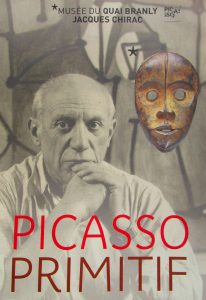
Picasso Primitive brochure cover detail. Photo by author.
Perhaps odder still was how the MQB left unpacked and decontextualized the notion of the primitive. The museum’s (and/or Picasso’s ?) definition all but ignored the history of this term and, as such, the discourse about it and the Other. In so doing, the show affirmed yet again an ethnocentric characterization of the MQB that James Clifford, among others, criticized the museum for entrenching after its 2006 opening. (See James Clifford, “Quai Branly in Process,” October, Spring 2007, 3–23.) The effects of refusing to detangle and define primitive were compounded by the relative lack of wall and brochure text explaining the history, circumstances of acquisition and display, and the socioreligious significances of most masks and statues shown or referenced in the exhibition. It was compounded by the MQB not sufficiently clarifying the sociopolitical and economic contexts in which Picasso traded images of unclothed Africans and created and sold art. In the 2010 Spectacular Art of Jean-Léon Gérôme exhibition at the J. Paul Getty Center in Brentwood, California (June 15–September 12, 2010), visitors learned that Gérôme’s prurient Orientalism was cultivated in relation to the contemporary European marketplace. The perhaps unintended impression that Primitive Picasso organizers hoped to titillate for monetary profit at the expense of the Other was accentuated by the absence of a similar analysis, if indeed the artworks on display were created for public, not private, consumption. Consumption was also underclarified.
More explanation was additionally necessary in the wall texts and brochures for Africa in the Capital. The largest section of the show was staged in the museum named after the king of Morocco, Mohammed VI. Here, visitors walked through rooms of paintings, sculpture, and photography that, according to one brochure, celebrated African creativity, African identity, African culture, the African art scene, and, in the case of at least one artist, humanity removed from racial identifiers. Exhibition materials informed us that the works of art were created by North and/or sub-Saharan Africans, including artists born and/or living off the continent. One example is the Moroccan-French photographer Leila Alaoui, who died shortly after a 2015 Burkina Faso terrorist attack while she was on assignment for Amnesty International. She was born in Paris and resided and worked in Europe, the United States, and Morocco. Alaoui, with her strong sense of injustice and interest in immigration, would probably note that the ability of some artists to easily move across borders is an elite privilege, an important distinction I could not find in exhibition materials. I could also see little discussion about the influences and significance of living and making art in diaspora cultures. The contradictions of an exhibition that was meant to celebrate diversity, yet included artists based upon ancestry alone, appeared lost on the organizers.
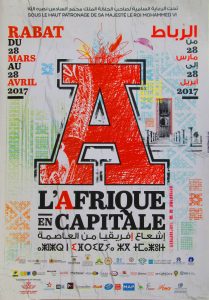
Africa in the Capital brochure cover. Photo by author.
Though the organizers intended Africa in the Capital City to celebrate African identity and creativity, the March 2017 opening and governmental support suggests an ulterior motive: to publicize Morocco’s reentry into the African Union (AU), made official in January 2017. The membership signifies a majority of AU member states’ acceptance of Morocco’s claims to the Western Sahara and its natural resources, a point of contention resulting in Morocco’s exit from a precursor to the AU and, over the decades, international condemnation of what former United Nations Secretary-General Ban Ki-moon called the Moroccan occupation. The controversy behind Morocco’s AU membership and actions in the Western Sahara was not part of the exhibition.
Also difficult to locate were critical artworks or narratives about contemporary Africa. One might conclude that there are no artworks that comment on accusations of corruption and cronyism, misuse of the environment, or violations of human rights, not to mention a lack of development; genocide; violence against women, the LGBT community, and minorities; and, of course, forced displacement and illegal immigration. The lacunae were all the more bizarre considering the inclusion of Alaoui, who depicted sub-Saharan immigrants in her 2014 Marrakesh Biennial submission Crossings and other artwork. As painfully indicated by the circumstances surrounding her demise and the deaths of African, European, and United States military and civilians, sticking one’s head in the proverbial sand cannot make problems disappear. Worse, the silence, like the silence at the MQB, arguably revictimizes her and others. The silence ignores the legacy of their work and sacrifice while leaving a door open to future transgressions. It is frankly unbefitting Morocco’s role and influence as an AU member in an exposition at a museum named after Morocco’s monarch and an exposition in 2017.
Again, I wonder if the MMVI and the MQB failed patrons, benefactors, and themselves. Perhaps we can ask the four vendors across the busy highway in front of the MQB on the day I visited. Of African descent, they were placing their wares for sale—miniature reproductions of the Eiffel Tower and similar iconic trinkets—on corded ground cloths used to collect items quickly should the police arrive to chase them away.
Finalists for the 2018 Morey and Barr Awards
posted by CAA — Nov 14, 2017
CAA is pleased to announce the 2018 finalists for the Charles Rufus Morey Book Award and two Alfred H. Barr Jr. Awards. The winners of the three prizes, along with the recipients of other Awards for Distinction, will be announced in January 2018 and presented during Convocation in conjunction with CAA’s 106th Annual Conference, taking place in Los Angeles, February 21-24, 2018.
Charles Rufus Morey Book Award
The Charles Rufus Morey Book Award honors an especially distinguished book in the history of art, published in any language between September 1, 2016, and August 31, 2017. The four finalists for 2018 are:
Benjamin Anderson, Cosmos and Community in Early Medieval Art (New Haven: Yale University Press, 2017)
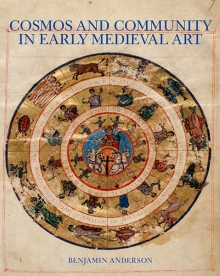
Susanna Berger, The Art of Philosophy: Visual Thinking in Europe from the Late Renaissance to the Early Enlightenment (Princeton: Princeton University Press, 2017)
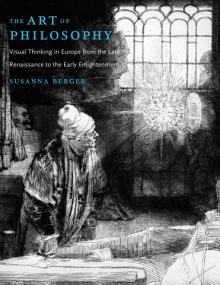
Laura Anne Kalba, Color in the Age of Impressionism: Commerce, Technology, and Art (University Park: Pennsylvania State University Press, 2017)
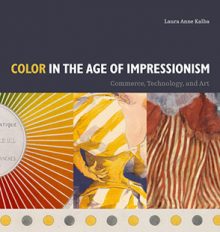
Dorothy Ko, The Social Life of Inkstones: Artisans and Scholars in Early Qing China (Seattle: University of Washington Press, 2017)
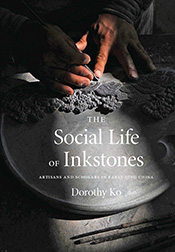
Alfred H. Barr Jr. Award
The Alfred H. Barr Jr. Award for museum scholarship is presented to the author(s) of an especially distinguished catalogue in the history of art, published between September 1, 2016, and August 31, 2017, under the auspices of a museum, library, or collection. The five finalists for 2018 are:
Matthew Affron, Paint the Revolution: Mexican Modernism, 1910-1950 (New Haven: Yale University Press, 2016)
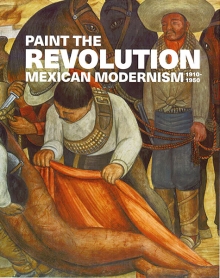
Wanda M. Corn, Georgia O’Keeffe: Living Modern (Brooklyn: Brooklyn Museum, 2017)
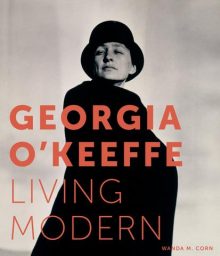
Robert Cozzolino, Anne Classen Knutson, and David M. Lubin, eds., World War I and American Art (Princeton: Princeton University Press, 2016)
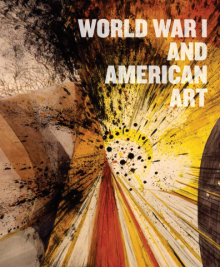
Barbara Drake Boehm and Melanie Holcomb, eds., Jerusalem, 1000-1400: Every People Under Heaven (New York: Metropolitan Museum of Art, 2016)
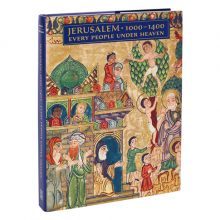
Pilar Silva Maroto, Bosch: The Fifth Centenary Exhibition (New York: Thames & Hudson, 2016)
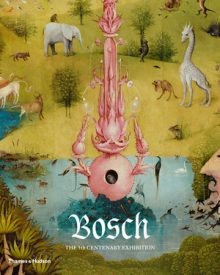
Alfred H. Barr Jr. Award for Smaller Museums, Libraries, Collections, and Exhibitions
In 2009, CAA established a second Barr award for the author(s) of catalogues produced by smaller museums, libraries, and collections with an annual operating budget of less than $10 million. The finalists for the second Barr award for 2018 are:
Melissa Rachleff, Inventing Downtown: Artist-Run Galleries in New York City, 1952-1965 (New York: Grey Art Gallery, New York University, 2017)
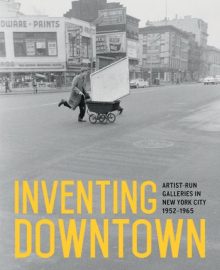
Jane Ashton Sharp, Thinking Pictures: The Visual Field of Moscow Conceptualism (New Brunswick, NJ: Zimmerli Art Museum, Rutgers, 2016)
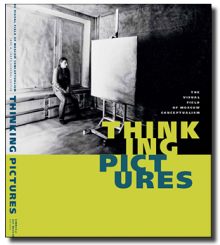
Kevin Sharp, ed., Wild Spaces, Open Seasons: Hunting and Fishing in American Art (Norman, OK: University of Oklahoma Press, 2016)
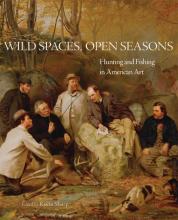
The presentation of the 2018 Awards for Distinction will take place on Wednesday evening, February 21, 6:00–7:30 PM, at the LA Convention Center in Los Angeles. The event is free and open to the public. For more information about CAA’s Awards for Distinction, please contact Aakash Suchak, CAA grants and special programs manager at 212-392-4435.
Meet the 2018 Participants in the CAA-Getty International Program
posted by CAA — Nov 14, 2017
CAA is pleased to announce this year’s participants in the CAA-Getty International Program. Now in its seventh year, the international program will bring fifteen new participants and five alumni to the 2018 Annual Conference in Los Angeles, February 21-24. The participants—professors of art history, curators, and artists who teach art history—hail from countries throughout the world, expanding CAA’s growing international membership and contributing to an increasingly diverse community of scholars and ideas. Selected by a jury of CAA members from a highly competitive group of applicants, the grant recipients will receive funding for travel expenses, hotel accommodations, conference registration, CAA membership, and per diems for out-of-pocket expenditures.
At a one-day preconference colloquium, to be held this year at the Getty Center, the fifteen new participants will discuss key issues in the international study of art history together with five CAA-Getty alumni and several CAA members from the United States, who also serve as hosts throughout the conference. The preconference program will delve deeper into subjects discussed during the past year’s CAA-Getty reunion, held at the 2017 Annual Conference, in which twenty alumni presented a series of conference sessions titled “Global Conversations.” Topics include such issues as postcolonial and Eurocentric legacies, interdisciplinary and transnational methodologies, and global trends in museum research and exhibitions.
The inclusion of five alumni is an added feature of this year’s CAA-Getty program. They will provide intellectual links between previous convenings of the international group and this year’s program and also serve as ombudsmen between CAA and the growing community of CAA-Getty alumni. In addition to contributing to the preconference colloquium, the five participating alumni will present a new Global Conversation during the 2018 conference titled Border Crossings: The Migration of Art, People, and Ideas.
The goal of the CAA-Getty International Program is to increase international participation in the organization’s activities, thereby expanding international networks and the exchange of ideas both during and after the conference. CAA currently includes members from 70 countries around the world. The CAA-Getty International Program is made possible with a generous grant from The Getty Foundation.
2018 Participants in the CAA-Getty International Program
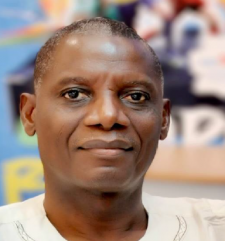 John Tokpabere Agberia is an artist, art historian, and curator. Graduating in 1983 from the University of Benin, Benin City, he began his academic career as a graduate assistant at the University of Uyo in 1985. He received an MA in art history at University of Ibadan in 1988 and a PhD from the University of Port Harcourt in 1998. Agberia has received several distinguished fellowships from the United Kingdom, including the AG Leventis fellowship at School of Oriental and African Studies (SOAS), University of London (1995), the Sainsbury Research fellowship of Sainsbury Research Unit at the University of East Anglia (1997), and the University of Oxford’s Titular fellowship at the Pitt Rivers Museum (2009). At Oxford Pitt Rivers, he worked with Jeremy Coote, the Joint Head of Collections where he began studying museums, cultural heritage, and curating. He has since become an active curator in Nigeria. Agberia is a professor of fine arts and design at the University of Port Harcourt, Nigeria.
John Tokpabere Agberia is an artist, art historian, and curator. Graduating in 1983 from the University of Benin, Benin City, he began his academic career as a graduate assistant at the University of Uyo in 1985. He received an MA in art history at University of Ibadan in 1988 and a PhD from the University of Port Harcourt in 1998. Agberia has received several distinguished fellowships from the United Kingdom, including the AG Leventis fellowship at School of Oriental and African Studies (SOAS), University of London (1995), the Sainsbury Research fellowship of Sainsbury Research Unit at the University of East Anglia (1997), and the University of Oxford’s Titular fellowship at the Pitt Rivers Museum (2009). At Oxford Pitt Rivers, he worked with Jeremy Coote, the Joint Head of Collections where he began studying museums, cultural heritage, and curating. He has since become an active curator in Nigeria. Agberia is a professor of fine arts and design at the University of Port Harcourt, Nigeria.
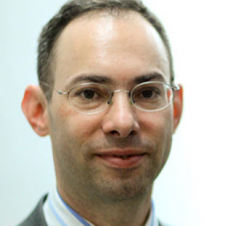 Felipe Soeiro Chaimovich was born in Santiago, Chile, and lives in São Paulo, Brazil. He earned a PhD in philosophy from the University of São Paulo and is a professor of art history, aesthetics, and art criticism at the Arts Faculty of Fundação Armando Álvares Penteado as well as the chief curator of the Museum of Modern Art, both located in São Paulo. He has three areas of academic research: mirrors as the origin of contemporary art, the confusion between gardens and nature in the ecological debate, and the aesthetics of taste and table manners. He has curated Sao Paolo’s International Garden Festival at Ibirapuera Park (2010) and Encounters of Art and Gastronomy at the city’s Museum of Modern Art (2012). Chaimovich is currently finishing a book on the origins of contemporary art that explores optics and the invention of perspective, Versailles, the relationship between mirrors and paintings, and the emergence of a new, self-reflexive working process in early 20th century art.
Felipe Soeiro Chaimovich was born in Santiago, Chile, and lives in São Paulo, Brazil. He earned a PhD in philosophy from the University of São Paulo and is a professor of art history, aesthetics, and art criticism at the Arts Faculty of Fundação Armando Álvares Penteado as well as the chief curator of the Museum of Modern Art, both located in São Paulo. He has three areas of academic research: mirrors as the origin of contemporary art, the confusion between gardens and nature in the ecological debate, and the aesthetics of taste and table manners. He has curated Sao Paolo’s International Garden Festival at Ibirapuera Park (2010) and Encounters of Art and Gastronomy at the city’s Museum of Modern Art (2012). Chaimovich is currently finishing a book on the origins of contemporary art that explores optics and the invention of perspective, Versailles, the relationship between mirrors and paintings, and the emergence of a new, self-reflexive working process in early 20th century art.
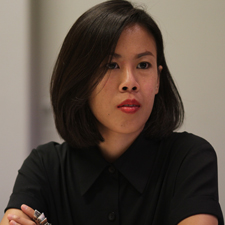 Thanavi Chotpradit is a lecturer in modern and contemporary Thai art history in the Department of Art History, Faculty of Archaeology, at Silpakorn University, Bangkok, Thailand. She is also a member of the editorial collective of Southeast of Now: Directions in Contemporary and Modern Art, a peer-reviewed journal dedicated to study of contemporary and modern art in Southeast Asia. She received her PhD in art history from Birkbeck, University of London, under a Royal Thai Government Scholarship. In 2015-16, Chotpradit participated in a cross-regional research program, “Ambitious Alignment: New Histories of Southeast Asian Art,” developed by the Power Institute Foundation for Art and Visual Culture, University of Sydney, Australia, and funded by the Getty Foundation’s Connecting Art Histories initiative. Her areas of interest include modern and Thai contemporary art in relation to memory studies, war commemoration, and Thai politics.
Thanavi Chotpradit is a lecturer in modern and contemporary Thai art history in the Department of Art History, Faculty of Archaeology, at Silpakorn University, Bangkok, Thailand. She is also a member of the editorial collective of Southeast of Now: Directions in Contemporary and Modern Art, a peer-reviewed journal dedicated to study of contemporary and modern art in Southeast Asia. She received her PhD in art history from Birkbeck, University of London, under a Royal Thai Government Scholarship. In 2015-16, Chotpradit participated in a cross-regional research program, “Ambitious Alignment: New Histories of Southeast Asian Art,” developed by the Power Institute Foundation for Art and Visual Culture, University of Sydney, Australia, and funded by the Getty Foundation’s Connecting Art Histories initiative. Her areas of interest include modern and Thai contemporary art in relation to memory studies, war commemoration, and Thai politics.
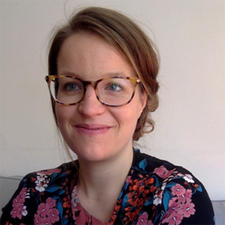 Katarzyna Cytlak is a Polish art historian based in Buenos Aires, Argentina, whose research focuses on the artistic creation of Central Europe in the second half of the twentieth century. As seen through a transmodern and transnational perspective, she studies conceptual art, radical and utopian architecture, socially engaged art, and art theory in relation to post-socialist countries. In 2012 she received a PhD from the University Paris 1 Panthéon-Sorbonne with a dissertation titled “The Grey Utopias: Architectural Projects in Central Europe in the 1970s.” Selected publications include articles in Umění/Art, Eadem Utraque Europa, Telón de Fondo, Third Text, and the RIHA Journal. Cytlak is currently a postdoctoral fellow at the Consejo Nacional de Investigaciones Científicas y Técnicas, Argentina (CONICET) and at the University of San Martín, Argentina. Her areas of research include East European and Latin American conceptual art, decolonial theory, and art history and criticism in post-communist countries.
Katarzyna Cytlak is a Polish art historian based in Buenos Aires, Argentina, whose research focuses on the artistic creation of Central Europe in the second half of the twentieth century. As seen through a transmodern and transnational perspective, she studies conceptual art, radical and utopian architecture, socially engaged art, and art theory in relation to post-socialist countries. In 2012 she received a PhD from the University Paris 1 Panthéon-Sorbonne with a dissertation titled “The Grey Utopias: Architectural Projects in Central Europe in the 1970s.” Selected publications include articles in Umění/Art, Eadem Utraque Europa, Telón de Fondo, Third Text, and the RIHA Journal. Cytlak is currently a postdoctoral fellow at the Consejo Nacional de Investigaciones Científicas y Técnicas, Argentina (CONICET) and at the University of San Martín, Argentina. Her areas of research include East European and Latin American conceptual art, decolonial theory, and art history and criticism in post-communist countries.
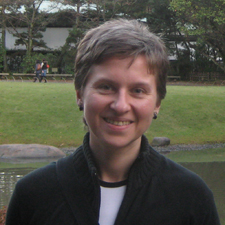 Anna Guseva is an associate professor in the School of History, Faculty of Humanities, National Research University Higher School of Economics (Moscow), where she has been a faculty member since 2014. She also directs a master’s program, “History of Art Culture and the Art Markets,” in the same department. Her research interests span both art and urban history in Russia and Asia in relation to food and rural history. Guseva graduated from the Lomonosov Moscow State University with a degree in art history in 1998 and received her PhD in architecture from the University of Tokyo in the Fujimori-Muramatsu Lab in 2011. She has organized architectural exhibitions as an independent curator, including My Melnikov (2013) and Environmentally Friendly Japanese Architecture: Taira Nishizawa Architects (2013), both at the Moscow Architectural Institute, and the latter also at the House of Architects in Nizniy Novgorod. Guseva also writes reviews for professional journals and trade publications on architecture and Asian art.
Anna Guseva is an associate professor in the School of History, Faculty of Humanities, National Research University Higher School of Economics (Moscow), where she has been a faculty member since 2014. She also directs a master’s program, “History of Art Culture and the Art Markets,” in the same department. Her research interests span both art and urban history in Russia and Asia in relation to food and rural history. Guseva graduated from the Lomonosov Moscow State University with a degree in art history in 1998 and received her PhD in architecture from the University of Tokyo in the Fujimori-Muramatsu Lab in 2011. She has organized architectural exhibitions as an independent curator, including My Melnikov (2013) and Environmentally Friendly Japanese Architecture: Taira Nishizawa Architects (2013), both at the Moscow Architectural Institute, and the latter also at the House of Architects in Nizniy Novgorod. Guseva also writes reviews for professional journals and trade publications on architecture and Asian art.
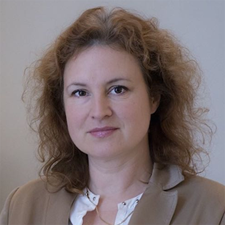 Markéta Hánová received a PhD in 2008 from Charles University in Prague, Czech Republic. Since 2000 she has been the curator of Japanese art at Prague’s National Gallery (NG). In 2012 she became the director of the Collection of Asian and African Art at the same institution. Hánová’s fields of interest include Japanese painting, ukiyo-e prints and Japonisme. She organized the exhibition Japonisme in Czech Art at the NG in 2014, one of many she has curated for the museum. In collaboration with the Japanese museums of art in Wakayama and Chiba she is currently developing an exhibition titled Japonisme in the Czech Lands to be presented in Japan in 2019. Her current research focuses on the popularity of collecting Japanese woodblock prints in the Czech lands in the late nineteen and early twentieth centuries. She has also reconceived the installation of Asian art at the NG Prague.
Markéta Hánová received a PhD in 2008 from Charles University in Prague, Czech Republic. Since 2000 she has been the curator of Japanese art at Prague’s National Gallery (NG). In 2012 she became the director of the Collection of Asian and African Art at the same institution. Hánová’s fields of interest include Japanese painting, ukiyo-e prints and Japonisme. She organized the exhibition Japonisme in Czech Art at the NG in 2014, one of many she has curated for the museum. In collaboration with the Japanese museums of art in Wakayama and Chiba she is currently developing an exhibition titled Japonisme in the Czech Lands to be presented in Japan in 2019. Her current research focuses on the popularity of collecting Japanese woodblock prints in the Czech lands in the late nineteen and early twentieth centuries. She has also reconceived the installation of Asian art at the NG Prague.
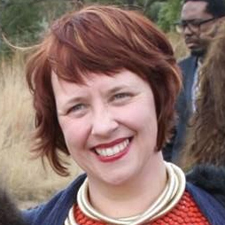 Alison Kearney is a Johannesburg-based artist and scholar of South African art, who lectures on art education in the School of Education at the University of the Witwatersrand (Wits). She obtained her PhD, titled “Beyond the Readymade: Found Objects in Contemporary South African art,” from Wits in 2016. She completed her master’s degree in fine art (with distinction) from the same university in 2004. Through her research Kearney interrogates the continuities and ruptures between African and Western art practices by critically exploring the ways in which Western avant-garde art practices and their attendant theories have informed contemporary African art. Kearney’s artworks have been featured in numerous exhibitions in South Africa, Switzerland and Australia. She has published scholarly work on contemporary South African art and develops education materials that facilitate particular engagements with art for the Wits Art Museum.
Alison Kearney is a Johannesburg-based artist and scholar of South African art, who lectures on art education in the School of Education at the University of the Witwatersrand (Wits). She obtained her PhD, titled “Beyond the Readymade: Found Objects in Contemporary South African art,” from Wits in 2016. She completed her master’s degree in fine art (with distinction) from the same university in 2004. Through her research Kearney interrogates the continuities and ruptures between African and Western art practices by critically exploring the ways in which Western avant-garde art practices and their attendant theories have informed contemporary African art. Kearney’s artworks have been featured in numerous exhibitions in South Africa, Switzerland and Australia. She has published scholarly work on contemporary South African art and develops education materials that facilitate particular engagements with art for the Wits Art Museum.
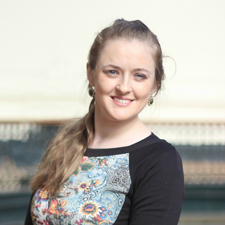 Natalia Keller is a graduate of Warsaw University (BA, 2010) and Utrecht University (MA, 2013), and a museum professional in a variety of cultural institutions in Europe and South America. Since 2014 she has been a researcher in the Collection Department of the National Museum of Fine Arts in Santiago de Chile where she studies its foreign works of art and their place within a Latin American context. Her research interests include prints and drawings, gender studies, and women artists. Keller has directed and participated in research and exhibition projects about female devotion in the Late Middle Ages, women’s involvement in the Academy during the 19th century, and contemporary Chilean women artists. She is especially interested in presenting art through the perspective of gender studies and visual and material culture, as well as through themes of community engagement and social justice.
Natalia Keller is a graduate of Warsaw University (BA, 2010) and Utrecht University (MA, 2013), and a museum professional in a variety of cultural institutions in Europe and South America. Since 2014 she has been a researcher in the Collection Department of the National Museum of Fine Arts in Santiago de Chile where she studies its foreign works of art and their place within a Latin American context. Her research interests include prints and drawings, gender studies, and women artists. Keller has directed and participated in research and exhibition projects about female devotion in the Late Middle Ages, women’s involvement in the Academy during the 19th century, and contemporary Chilean women artists. She is especially interested in presenting art through the perspective of gender studies and visual and material culture, as well as through themes of community engagement and social justice.
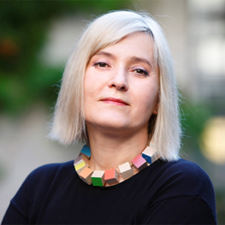 Sandra Križić Roban received a PhD from the Department of Art History, Faculty of Philosophy, at the University of Zagreb, Croatia. Active as a critic, curator, lecturer, and writer, Križić Roban is a senior research advisor at the Institute of Art History in Zagreb, where she also serves as editor-in-chief of the art journal Život umjetnosti. Together with colleagues she established the Office for Photography in 2013, a nonprofit association dedicated to researching and promoting contemporary photography. She is the author of the only two comprehensive studies of contemporary photography and painting in Croatia: At Second Glance: the Position of Contemporary Croatian Photography (2010), and Croatian Painting from 1945 to Today (2013). Within the project Postmedia and Non-institutional Art Practices from the 1960s she has organized three international conferences on contemporary arts. Križić Roban’s main research topics include contemporary art, history and theory of photography, post-war architecture, public space discourse, and contemporary war memorials.
Sandra Križić Roban received a PhD from the Department of Art History, Faculty of Philosophy, at the University of Zagreb, Croatia. Active as a critic, curator, lecturer, and writer, Križić Roban is a senior research advisor at the Institute of Art History in Zagreb, where she also serves as editor-in-chief of the art journal Život umjetnosti. Together with colleagues she established the Office for Photography in 2013, a nonprofit association dedicated to researching and promoting contemporary photography. She is the author of the only two comprehensive studies of contemporary photography and painting in Croatia: At Second Glance: the Position of Contemporary Croatian Photography (2010), and Croatian Painting from 1945 to Today (2013). Within the project Postmedia and Non-institutional Art Practices from the 1960s she has organized three international conferences on contemporary arts. Križić Roban’s main research topics include contemporary art, history and theory of photography, post-war architecture, public space discourse, and contemporary war memorials.
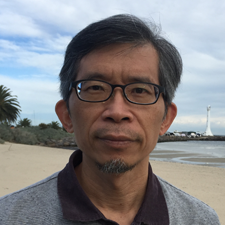
Hsin-tien Liao holds PhDs in art history (University of Central England in Birmingham, UK) and sociology (National Taiwan University, Taipei, Taiwan). He is the dean of the College of Humanities at the National Taiwan University of Arts and also teaches at the school’s Graduate School of Art Management and Culture Policy. From 2010-13 he was a senior lecturer at Australian National University where he is now an honorary professor. Liao’s research focuses on calligraphy, Taiwanese art, the sociology of art, and postcolonial visual art. Recent publications include The Tension of Art: Taiwanese Fine Art and the Politics of Culture (2010), Extending Knowledge through Investigating Art (2013), and A New Thinking on Taiwanese Art: Framework, Criticism, and Aesthetics (2017). He has written biographies about two modern Taiwanese printmakers: Liao Shiou-ping (2016) and Li Xi-chi (2017). In 2013 he published a Chinese translation of Kenneth Clark’s Landscape into Art. In 2016, he established the Taiwanese Art History Association and became its first chair.
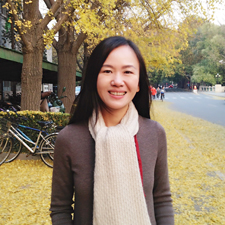 Chen Liu teaches art history and architecture at Tsinghua University in Beijing, China, where she received a bachelor’s degree in architecture with honors. After receiving a master’s in architecture and urban planning from the University of Maryland in 2000, she practiced as an architect in Washington DC until 2005. In 2011, she received a PhD in art history from Princeton University, specializing in Renaissance and Baroque art and architecture. In 2012, funded by an Andrew W. Mellow Fellowship, she helped create and direct the first Villa I Tatti summer research seminar designed specifically for Chinese scholars. “The Unity of the Arts in Renaissance Italy” provided participants with the opportunity to study firsthand the art and architecture of Renaissance Italy. Liu also teaches courses on the visual arts at Beijing Film Academy and Tongji University (Shanghai). She publishes widely on early modern art and architecture, as well as on the response of Chinese scholars to the Italian Renaissance.
Chen Liu teaches art history and architecture at Tsinghua University in Beijing, China, where she received a bachelor’s degree in architecture with honors. After receiving a master’s in architecture and urban planning from the University of Maryland in 2000, she practiced as an architect in Washington DC until 2005. In 2011, she received a PhD in art history from Princeton University, specializing in Renaissance and Baroque art and architecture. In 2012, funded by an Andrew W. Mellow Fellowship, she helped create and direct the first Villa I Tatti summer research seminar designed specifically for Chinese scholars. “The Unity of the Arts in Renaissance Italy” provided participants with the opportunity to study firsthand the art and architecture of Renaissance Italy. Liu also teaches courses on the visual arts at Beijing Film Academy and Tongji University (Shanghai). She publishes widely on early modern art and architecture, as well as on the response of Chinese scholars to the Italian Renaissance.
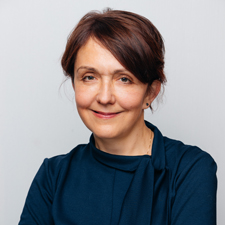 Natalia Moussienko is a leading research fellow at the Modern Art Research Institute of the National Academy of Arts of Ukraine (Kyiv). She is the author of numerous books and articles on art history, cultural diplomacy, cinema, and urbanism, including Art of Maidan (2016), Kyiv Art Space (2013), and Arts and Politics (2002). In 2016 the National Academy of Arts of Ukraine awarded Moussienko a Golden Medal for her achievements in cultural diplomacy. She was also awarded a Fulbright scholarship to conduct research at the Kennan Institute, Wilson Center, in Washington DC (2011-2012) and a Thesaurus Polonia fellowship to study at the International Cultural Center in Krakow (2017). Moussienko is an initiator and curator of the Art of Maidan, a continuing project begun in 2014 to document the explosion of artistic creativity during the Revolution of Dignity in 2013-14. Central to the project is a book and exhibition that has already been presented in sixteen locations in Ukraine, the United States, and Europe.
Natalia Moussienko is a leading research fellow at the Modern Art Research Institute of the National Academy of Arts of Ukraine (Kyiv). She is the author of numerous books and articles on art history, cultural diplomacy, cinema, and urbanism, including Art of Maidan (2016), Kyiv Art Space (2013), and Arts and Politics (2002). In 2016 the National Academy of Arts of Ukraine awarded Moussienko a Golden Medal for her achievements in cultural diplomacy. She was also awarded a Fulbright scholarship to conduct research at the Kennan Institute, Wilson Center, in Washington DC (2011-2012) and a Thesaurus Polonia fellowship to study at the International Cultural Center in Krakow (2017). Moussienko is an initiator and curator of the Art of Maidan, a continuing project begun in 2014 to document the explosion of artistic creativity during the Revolution of Dignity in 2013-14. Central to the project is a book and exhibition that has already been presented in sixteen locations in Ukraine, the United States, and Europe.
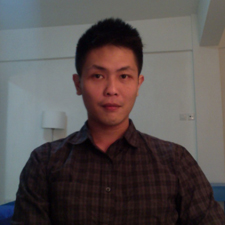 Simon Soon is a researcher and senior lecturer in the Visual Art Department of the Cultural Centre, University of Malaya, located in Kuala Lumpur, Malaysia. He completed a PhD in art history at the University of Sydney with a dissertation titled, “What is Left of Art? The Spatio-Visual Practice of Political Art in Indonesia, Singapore, Thailand, and the Philippines, 1950s–1970s.” Soon studies comparative modernities in art, urban histories, and art historiography and writes on various topics related to twentieth-century art across Asia. He is also a co-editor of Narratives of Malaysian Art, Vol. 4. He is the Penang field director for the Power Institute, University of Sydney’s “Site and Space of Southeast Asia,” funded by Getty Foundation’s Connecting Art Histories Initiative. He is also an editorial member of Southeast of Now: Directions in Contemporary and Modern Art, a peer-review journal published by NUS Press (National University of Singapore) and a team member of Malaysia Design Archive.
Simon Soon is a researcher and senior lecturer in the Visual Art Department of the Cultural Centre, University of Malaya, located in Kuala Lumpur, Malaysia. He completed a PhD in art history at the University of Sydney with a dissertation titled, “What is Left of Art? The Spatio-Visual Practice of Political Art in Indonesia, Singapore, Thailand, and the Philippines, 1950s–1970s.” Soon studies comparative modernities in art, urban histories, and art historiography and writes on various topics related to twentieth-century art across Asia. He is also a co-editor of Narratives of Malaysian Art, Vol. 4. He is the Penang field director for the Power Institute, University of Sydney’s “Site and Space of Southeast Asia,” funded by Getty Foundation’s Connecting Art Histories Initiative. He is also an editorial member of Southeast of Now: Directions in Contemporary and Modern Art, a peer-review journal published by NUS Press (National University of Singapore) and a team member of Malaysia Design Archive.
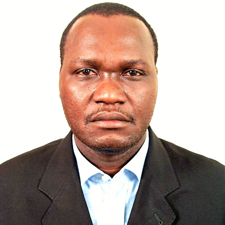 Romuald Tchibozo is an art historian from Benin. He received his PhD in 2003 from the Humboldt University of Berlin with a dissertation titled “Art and Arbitrary: a Study of the African Contemporary Art Reception in the West: the German Case from 1950 to the Present Day.” Currently, he is a senior lecturer of art history in the Archaeology and History Department, Faculty of Arts and Humanities, National Institute of Art, Archaeology and Cultural Craft, at the University of Abomey-Calavi, Benin. He also teaches art history at the Centre Régional d’Action Culturelle of Lomé in Togo. In 2013-14, Tchibozo was a fellow in the Art Histories and Aesthetic Practices program, an initiative of the Max-Planck-Institute at the Forum for Transregional Studies in Berlin. His research focuses on African contemporary art in the former German Democratic Republic, the evolution of contemporary art in Benin, and heritage issues, such as the Yoruba Gèlèdè Society and the practice of art history.
Romuald Tchibozo is an art historian from Benin. He received his PhD in 2003 from the Humboldt University of Berlin with a dissertation titled “Art and Arbitrary: a Study of the African Contemporary Art Reception in the West: the German Case from 1950 to the Present Day.” Currently, he is a senior lecturer of art history in the Archaeology and History Department, Faculty of Arts and Humanities, National Institute of Art, Archaeology and Cultural Craft, at the University of Abomey-Calavi, Benin. He also teaches art history at the Centre Régional d’Action Culturelle of Lomé in Togo. In 2013-14, Tchibozo was a fellow in the Art Histories and Aesthetic Practices program, an initiative of the Max-Planck-Institute at the Forum for Transregional Studies in Berlin. His research focuses on African contemporary art in the former German Democratic Republic, the evolution of contemporary art in Benin, and heritage issues, such as the Yoruba Gèlèdè Society and the practice of art history.
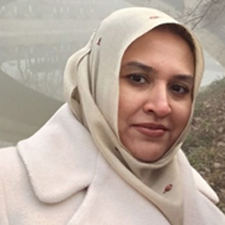 Sarah Umer is an assistant professor in the Institute of Visual Arts & Design at Lahore College for Women, the largest women’s university in Pakistan and one of the largest in South Asia. In addition to teaching undergraduate and graduate students, Umer organizes seminars and conferences with universities and museums on a national and international level. Her research interests include the study of ancient civilizations and religions, predominantly in the South Asian region. In 2016, Umer received a PhD from Lahore College for Women with a dissertation on the religious beliefs of the Indus Valley people. In early 2017, as a recipient of a Charles Wallace Fellowship, she probed this topic further at SOAS (School of Oriental and African Studies), University of London. In particular, she studied the cuneiform tablets of Mesopotamia to see if this civilization may have shared religious beliefs with the Indus Valley culture, in addition to their known trading connections.
Sarah Umer is an assistant professor in the Institute of Visual Arts & Design at Lahore College for Women, the largest women’s university in Pakistan and one of the largest in South Asia. In addition to teaching undergraduate and graduate students, Umer organizes seminars and conferences with universities and museums on a national and international level. Her research interests include the study of ancient civilizations and religions, predominantly in the South Asian region. In 2016, Umer received a PhD from Lahore College for Women with a dissertation on the religious beliefs of the Indus Valley people. In early 2017, as a recipient of a Charles Wallace Fellowship, she probed this topic further at SOAS (School of Oriental and African Studies), University of London. In particular, she studied the cuneiform tablets of Mesopotamia to see if this civilization may have shared religious beliefs with the Indus Valley culture, in addition to their known trading connections.
Participating Alumni
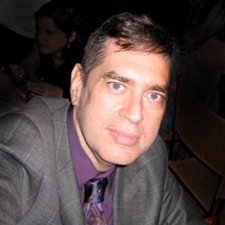 Cezar Bartholomeu is an artist and professor of art history at the School of Fine Arts, Universidade Federal do Rio de Janeiro (UFRJ), in Brazil. He received a PhD in visual languages from both the UFRJ and the École de Hautes Études in Paris. Between 2010-17 he was the editor-in-chief of Arte & Ensaios, one of Brazil’s major art journals. His areas of research include photography as art, photography’s history and theory, and photography in Brazil. As an artist, Bartholomeu exhibits widely in Brazil and Europe. His publications include Celebrações/Negociações – Fotografia Africana na coleção Gilberto Chateaubriand (African Photography in the Gilberto Chateaubriand Collection, Museum of Modern Art, Rio de Janeiro, 2011), “Emanation/Abjection” in Laboratório Público de Históra da Arte Mundial (Public World Art History Lab, Rio de Janeiro: UERJ, 2014), and “Thirty Times Failed: Valério Vieira and Experimental Photography in Brazil” in Photography and Failure (New York: Bloomsbury, 2017).
Cezar Bartholomeu is an artist and professor of art history at the School of Fine Arts, Universidade Federal do Rio de Janeiro (UFRJ), in Brazil. He received a PhD in visual languages from both the UFRJ and the École de Hautes Études in Paris. Between 2010-17 he was the editor-in-chief of Arte & Ensaios, one of Brazil’s major art journals. His areas of research include photography as art, photography’s history and theory, and photography in Brazil. As an artist, Bartholomeu exhibits widely in Brazil and Europe. His publications include Celebrações/Negociações – Fotografia Africana na coleção Gilberto Chateaubriand (African Photography in the Gilberto Chateaubriand Collection, Museum of Modern Art, Rio de Janeiro, 2011), “Emanation/Abjection” in Laboratório Público de Históra da Arte Mundial (Public World Art History Lab, Rio de Janeiro: UERJ, 2014), and “Thirty Times Failed: Valério Vieira and Experimental Photography in Brazil” in Photography and Failure (New York: Bloomsbury, 2017).
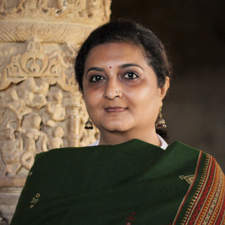 Parul Pandya Dhar is an associate professor of South and Southeast Asian art history in the Department of History, University of Delhi, where she researches and teaches premodern Indian art history and connected histories of Asian art. She has authored The Toraṇa in Indian and Southeast Asian Architecture (2010), edited Indian Art History: Changing Perspectives (2011), and co-edited Temple Architecture and Imagery of South and Southeast Asia (2016), Asian Encounters: Exploring Connected Histories (2014), and Cultural Interface of India with Asia: Religion, Art and Architecture (2004). Dhar has served as a jury member, peer reviewer, and editorial board member for numerous international conferences, publications, and journals. She was awarded the Nehru Trust Travel Grant, UK, in 2004, the Alexander von Humboldt Post-Doctoral Research Fellowship, Berlin, in 2007-08, and the CAA-Getty International Program award in 2012. She is a participating alumna of the CAA-Getty program in 2018. Dhar is also a well-known Bharatanatyam artist.
Parul Pandya Dhar is an associate professor of South and Southeast Asian art history in the Department of History, University of Delhi, where she researches and teaches premodern Indian art history and connected histories of Asian art. She has authored The Toraṇa in Indian and Southeast Asian Architecture (2010), edited Indian Art History: Changing Perspectives (2011), and co-edited Temple Architecture and Imagery of South and Southeast Asia (2016), Asian Encounters: Exploring Connected Histories (2014), and Cultural Interface of India with Asia: Religion, Art and Architecture (2004). Dhar has served as a jury member, peer reviewer, and editorial board member for numerous international conferences, publications, and journals. She was awarded the Nehru Trust Travel Grant, UK, in 2004, the Alexander von Humboldt Post-Doctoral Research Fellowship, Berlin, in 2007-08, and the CAA-Getty International Program award in 2012. She is a participating alumna of the CAA-Getty program in 2018. Dhar is also a well-known Bharatanatyam artist.
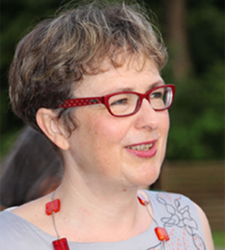 Ildikó Gericsné Fehér received an MA and PhD in art history from Eötvös Loránd University in Budapest, Hungary. As associate professor in the Department of Art History of the Hungarian University of Fine Arts in Budapest, she lectures and leads seminars on Renaissance and Baroque art. She is also a consultant to the university’s Conservation Department. Fehér’s research interests include detached wall paintings from medieval and Renaissance Italy in the collection of the Museum of Fine Arts Budapest; Florentine art dealers at the end of the nineteenth century; Károly Pulszky’s purchases of paintings in Italy for the museum circa 1890; wall paintings in Umbria from the fourteenth to sixteenth century; self-portraits by Hungarian artists in the Uffizi Gallery; and the works of Jacopo Palma il Giovane.
Ildikó Gericsné Fehér received an MA and PhD in art history from Eötvös Loránd University in Budapest, Hungary. As associate professor in the Department of Art History of the Hungarian University of Fine Arts in Budapest, she lectures and leads seminars on Renaissance and Baroque art. She is also a consultant to the university’s Conservation Department. Fehér’s research interests include detached wall paintings from medieval and Renaissance Italy in the collection of the Museum of Fine Arts Budapest; Florentine art dealers at the end of the nineteenth century; Károly Pulszky’s purchases of paintings in Italy for the museum circa 1890; wall paintings in Umbria from the fourteenth to sixteenth century; self-portraits by Hungarian artists in the Uffizi Gallery; and the works of Jacopo Palma il Giovane.
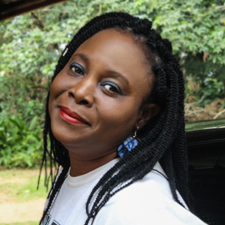 Peju Layiwola is an artist and professor of art history, Department of Creative Arts, University of Lagos, Nigeria. Through her writing and multimedia works Layiwola has addressed the tragic impact of the British Expedition to Benin, Nigeria, in 1897. Her focus on memory, Benin art and culture, and female participation in the visual arts in Nigeria has led to several articles in edited volumes such as Benin Kings and Rituals: Court Arts from Nigeria (2007), Writing African Women: Gender, Popular Culture and Literature in West Africa (1997) and N.Paradoxa, an international feminist journal (2013). Layiwola’s art has featured in several exhibitions within and outside Nigeria, including Benin1897.com: Art and the Restitution Question (Main Auditorium Gallery, University of Lagos, 2010), Whose Centenary? (Igun Street, Benin City, 2014) and a traveling exhibition Boundary Object organized by Artefakte, Berlin (Dresden, Madrid, 2015-16). She is currently head of the Department of Creative Arts, University of Lagos, Nigeria.
Peju Layiwola is an artist and professor of art history, Department of Creative Arts, University of Lagos, Nigeria. Through her writing and multimedia works Layiwola has addressed the tragic impact of the British Expedition to Benin, Nigeria, in 1897. Her focus on memory, Benin art and culture, and female participation in the visual arts in Nigeria has led to several articles in edited volumes such as Benin Kings and Rituals: Court Arts from Nigeria (2007), Writing African Women: Gender, Popular Culture and Literature in West Africa (1997) and N.Paradoxa, an international feminist journal (2013). Layiwola’s art has featured in several exhibitions within and outside Nigeria, including Benin1897.com: Art and the Restitution Question (Main Auditorium Gallery, University of Lagos, 2010), Whose Centenary? (Igun Street, Benin City, 2014) and a traveling exhibition Boundary Object organized by Artefakte, Berlin (Dresden, Madrid, 2015-16). She is currently head of the Department of Creative Arts, University of Lagos, Nigeria.
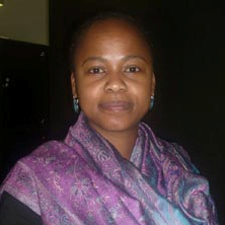 Nomusa Makhubu holds a PhD in art history and visual culture from Rhodes University, South Africa. A senior lecturer of art history at the University of Cape Town’s Michaelis School of Fine Art, Makhubu studies art interventionism, popular culture, and social engagement in African visual art. She is the recipient of the ABSA L’Atelier Gerard Sekoto Award (2006), the Prix du Studio National des Arts Contemporain, Le Fresnoy (2014) and the First Runner Up in the Department of Science and Technology (DST) Women in Science Awards (2017). Makhubu is a member of the South African Young Academy of Science and Chair of the Africa South Art Initiative. In 2016, she was a fellow of the American Council of Learned Societies and an African Studies Association (ASA) Presidential Fellow. Makhubu is currently an Institute for Creative Arts fellow (University of Cape Town) and a Mandela-Mellon Fellow at the Hutchins Center for African and African American Studies, Harvard University.
Nomusa Makhubu holds a PhD in art history and visual culture from Rhodes University, South Africa. A senior lecturer of art history at the University of Cape Town’s Michaelis School of Fine Art, Makhubu studies art interventionism, popular culture, and social engagement in African visual art. She is the recipient of the ABSA L’Atelier Gerard Sekoto Award (2006), the Prix du Studio National des Arts Contemporain, Le Fresnoy (2014) and the First Runner Up in the Department of Science and Technology (DST) Women in Science Awards (2017). Makhubu is a member of the South African Young Academy of Science and Chair of the Africa South Art Initiative. In 2016, she was a fellow of the American Council of Learned Societies and an African Studies Association (ASA) Presidential Fellow. Makhubu is currently an Institute for Creative Arts fellow (University of Cape Town) and a Mandela-Mellon Fellow at the Hutchins Center for African and African American Studies, Harvard University.
For more information about the CAA-Getty International Program, please contact project director Janet Landay at jlanday@collegeart.org or 212-392-4420.
2018 CAA-Getty International Program Participants Selected
posted by CAA — Oct 10, 2017
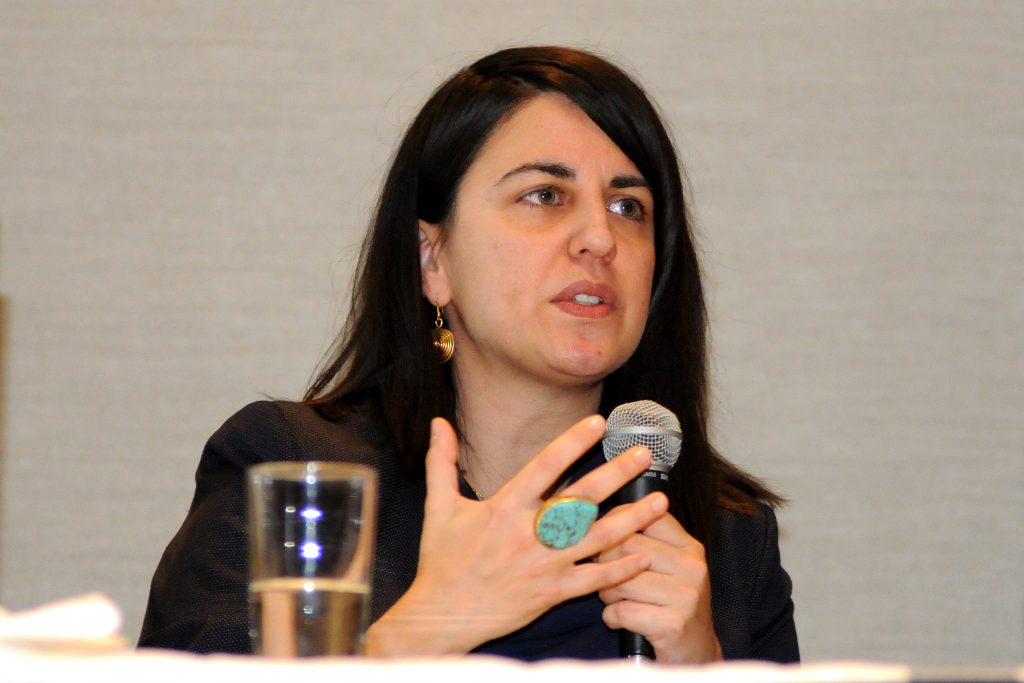 CAA is pleased to announce this year’s participants in the CAA-Getty International Program. Now in its seventh year, the international program will bring fifteen new participants and five alumni to the 2018 Annual Conference in Los Angeles, February 21-24. The participants—professors of art history, curators, and artists who teach art history—hail from countries throughout the world, expanding CAA’s growing international membership and contributing to an increasingly diverse community of scholars and ideas. Selected by a jury of CAA members from a highly competitive group of applicants, the grant recipients will receive funding for travel expenses, hotel accommodations, conference registration, CAA membership, and per diems for out-of-pocket expenditures.
CAA is pleased to announce this year’s participants in the CAA-Getty International Program. Now in its seventh year, the international program will bring fifteen new participants and five alumni to the 2018 Annual Conference in Los Angeles, February 21-24. The participants—professors of art history, curators, and artists who teach art history—hail from countries throughout the world, expanding CAA’s growing international membership and contributing to an increasingly diverse community of scholars and ideas. Selected by a jury of CAA members from a highly competitive group of applicants, the grant recipients will receive funding for travel expenses, hotel accommodations, conference registration, CAA membership, and per diems for out-of-pocket expenditures.
At a one-day preconference colloquium, to be held this year at the Getty Center, the fifteen new participants will discuss key issues in the international study of art history together with five CAA-Getty alumni and several CAA members from the United States, who also serve as hosts throughout the conference. The preconference program will delve deeper into subjects discussed during the past year’s CAA-Getty reunion, held at the 2017 Annual Conference, in which twenty alumni presented a series of conference sessions titled “Global Conversations.” Topics include such issues as postcolonial and Eurocentric legacies, interdisciplinary and transnational methodologies, and global trends in museum research and exhibitions.
The inclusion of five alumni is an added feature of this year’s CAA-Getty program. They will provide intellectual links between previous convenings of the international group and this year’s program and also serve as ombudsmen between CAA and the growing community of CAA-Getty alumni. In addition to contributing to the preconference colloquium, the five participating alumni will present a new Global Conversation during the 2018 conference titled Border Crossings: The Migration of Art, People, and Ideas.
The goal of the CAA-Getty International Program is to increase international participation in the organization’s activities, thereby expanding international networks and the exchange of ideas both during and after the conference. CAA currently includes members from 70 countries around the world. The CAA-Getty International Program is made possible with a generous grant from The Getty Foundation.
2018 Participants in the CAA-Getty International Program
John Agberia, Professor, Department of Fine Arts & Design, University of Port Harcourt, Nigeria
Felipe Chaimovich, Chief Curator and Professor, Museo de Arte Moderna de São Paulo Fundação Armando Álvares Penteado, Brazil
Chen Liu, Associate Professor, Tsinghua University, Beijing, China
Thanavi Chotpradit, Lecturer, Silpakorn University, Bangkok, Thailand
Katarzyna Cytlak, postdoctoral researcher, Universidad Nacional de San Martín, Buenos Aires, Argentina
Anna Guseva, Associate Professor, Higher School of Economics, Moscow, Russia
Marketa Hanova, Director of the Collection of Asian Art, The National Gallery in Prague, Czech Republic
Alison Kearney, Lecturer, University of the Witwatersrand (Wits), Johannesburg, South Africa
Natalia Keller, Researcher of the Collection Department, Museo Nacional de Bellas Artes, Santiago, Chile
Hsin-tien Liao, Dean of College of Humanities, National Taiwan University of Arts, New Taipei City, Taiwan
Natalia Moussienko, Leading Research Fellow, Modern Art Research Institute, National Academy of Arts, Kiev, Ukraine
Sandra Krizic Roban, Senior Research Advisor, Institute of Art History, Zagreb, Croatia
Simon Soon, Senior Lecturer, University of Malaya /Malaysia Design Archive, Kuala Lumpur, Malaysia
Romuald Tchibozo, Senior Lecturer, University of Abomey-Calavi, Benin
Sarah Umer, PhD Coordinator/ Assistant Professor, Lahore College for Women University, Pakistan
Participating Alumni
Cezar Bartholomeu, Assistant Professor, School of Fine Arts, Universidade Federal do Rio de Janeiro, Brazil
Parul Pandya Dhar, Associate Professor, Department of History, University of Delhi, India
Ildikó Fehér, Associate Professor, Hungarian Academy of Fine Arts, Budapest, Hungary
Peju Layiwola, Professor of Art History, Department of Creative Arts University of Lagos, Nigeria
Nomusa Makhubu, Senior Lecturer, Michaelis School of Fine Art, University of Cape Town, South Africa
Affiliated Society News for September 2017
posted by CAA — Sep 27, 2017
Leading subject association for art history in the UK announces new identity
Since July 2017, the leading subject association for art history in the United Kingdom, the Association of Art Historians, has been known as the Association for Art History. The change of name and new identity mark the beginning of a new era for the Association, following a review of its role in shaping the future for art history.
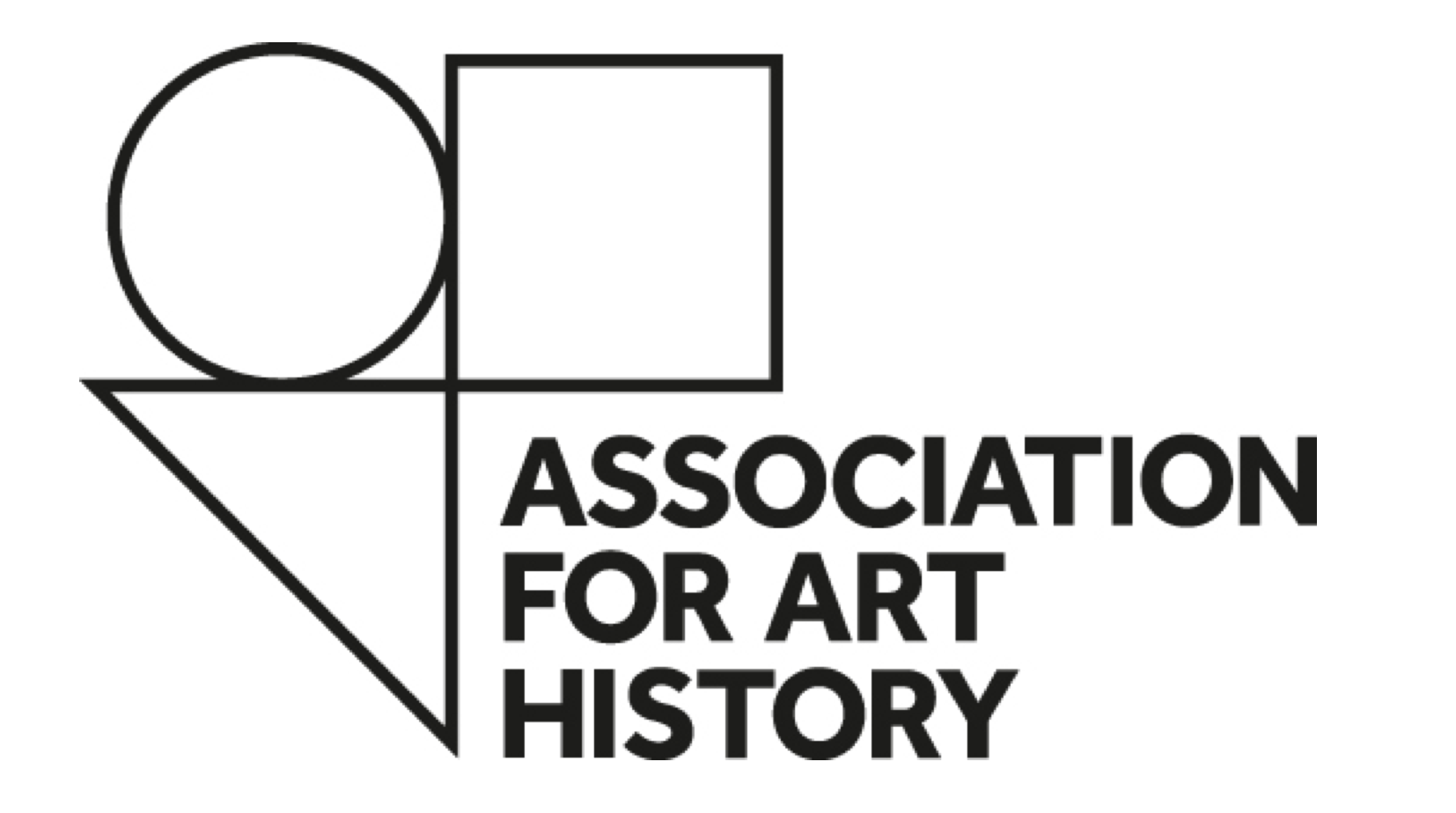
The Association’s mission since its foundation in 1974 has been to champion art history for all. Working in partnership with London-based agency Spencer du Bois to build upon this original ethos, the new identity restates their role as advocates for art history.
The new graphic identity feeds into their wider campaigning and audience development work to increase awareness, understanding, and engagement with art history, particularly in education. Highlights from their education campaign and 2018 program will be announced this autumn. Their ambition is to encourage people across the UK to recognize the ways in which learning about art history offers a unique insight into the world: to encourage people to think differently; to see differently.
Pontus Rosén, CEO of the Association for Art History, states, “Our strength as the national subject association for art history relies on how we express ourselves to new and existing audiences. The name change and rebrand demonstrates our commitment to be more visible and vocal for the subject.”
Christine Riding, Chair of the Association, said, “In 1974 we were radical in our approach. We wanted to change the way people perceived art history, we dared to do things differently. For over 40 years we have championed a broad and inclusive art history for the many not the few. Our ethos has always been one of inclusivity and our new identity reinforces that inclusivity.”
More details can be found on the new website.
Alliance for Arts in Research Universities (A2ru)
The Alliance for the Arts in Research Universities (a2ru) is pleased to announce the 2017 a2ru National Conference, hosted by Northeastern University with additional conference events throughout hosted by Boston University, Massachusetts Institute of Technology, and Tufts University, November 1-4, 2017.
Arts in the Public Sphere: Civility, Advocacy, and Engagement will use the city of Boston as a starting point for discussion and engagement. As a 21st century global city, Boston embodies many of the issues that drive diverse contemporary cultural contexts. It supports a rich and continually evolving sense of civic realms, and is home to leading arts, educational, medical, industrial and corporate entities invested in innovative modes of research, practice and civic participation. There is also clear recognition that the ‘public sphere’ is not confined to large metropolitan regions. Creating dynamic communities that engage and extend beyond traditional boundaries—in both virtual and material ways—remains a growing challenge and the work before us.
The 2017 conference will include working groups, panels, and presentations from representatives from over 50 institutions across the world. Keynotes and conversations will feature thought leaders including Jamie Bennett (ArtPlace America), Jeremy Liu (PolicyLink), Peter Galison (Harvard University), Rick Lowe (Project Row Houses and the University of Houston), and Maria Rosario Jackson (The Kresge Foundation). Plenary panels addressing issues related to funding, higher education, and arts as research will include Kent Devereaux (New Hampshire Institute of Art), Jason Schupbach (Arizona State University), Steven Tepper (Arizona State University), Elizabeth Hudson (Northeastern University), and Julia Smith (Association of American Universities), and E. San San Wong (Barr Foundation).
Registration is open now through October 25. To register and for more information, please visit the conference website.
Society for Photographic Education
Society for Photographic Education’s 55th Annual Conference, Uncertain Times: Borders, Refuge, Community, Nationhood, will take place March 14, 2018, in Philadelphia, PA. Connect with 1,600 artists, educators, and photographers from around the world for programming that will fuel your creativity – four days of presentations, industry seminars, and critiques to engage you! Explore an exhibits fair featuring the latest equipment, processes, publications, and photography/media schools. Participate in one-on-one portfolio critiques, and informal portfolio sharing. Other highlights include a print raffle, silent auction, mentoring sessions,
film screenings, exhibitions, receptions, a dance party, and more!
Registration will open on November 1, 2017.
The most recent number of SECAC’s annual journal, Art Inquiries (formerly the SECAC Review), has been published. The current issue includes book and exhibition reviews, feature articles on Gustave Caillebotte, Andy Warhol, Robert Irwin, and Greek vase painting, and an interview with sculptor Duane Paxson whose work is featured on the cover.
The 73rd Annual SECAC Conference, hosted by the Columbus College of Art & Design, will be held in Columbus, Ohio, October 25 through 28, 2017. Keynote speakers are Heidelberg Project founder Tyree Guyton and the project’s Executive Director Jenenne Whitfield. Off-site events during the conference will include a Thursday evening Open House at CCAD featuring the SECAC 2017 Juried Exhibition, a Friday evening reception at the Pizzuti Collection, and extended hours at the newly renovated Columbus Museum of Art.
TIAMSA – The International Art Market Studies Association
After a fantastic response to our call for papers, TIAMSA’s first international conference on ‘Art Fairs’ united 28 speakers from countries worldwide who explored this year’s theme in six sessions. Held at Sotheby’s Institute of Art in London on July 13-15, 2017, the conference featured two keynotes, one by Sophie Raux (Université Lumière – Lyon 2), who provided fascinating insights into the early history of art fairs in the 16th and 17th centuries, the other by Noah Horowitz (Director Americas / Member of the Executive Committee, Art Basel), who responded to questions from Olav Velthuis and the audience. The conference featured six sessions addressing subjects such as “Standards of Quality and Vetting,“ “Historical and Geographic Contexts” or “Biennales and Nascent Fairs.” Carried by many excellent papers, the event not only showed that the subject of the art fair still offers many facets that deserves further exploration; the conference was also marked by enthusiasm, lively debate, and intensive networking!
The conference was preceded by three memorable events open to TIAMSA members, namely an exploration of the Agnew’s Archive at the National Gallery, London with Alan Crookham (Head of NG Research Centre); a guided tour with Highlights of the National Gallery’s Collection History with Susanna Avery-Quash (Curator at the NG); and an inside tour of Thaddaeus Ropac’s new London gallery, with Polly Gaer, Gallery Director.
We were also happy that many of our members attended our second Annual General Meeting, held just before our conference. We looked back on our first year, fine-tuned our ‘modus operandi’, and elected and cordially welcomed four new board members: Kim Oosterlinck (University of Bruxelles), Iain Robertson (Sotheby’s Institute), Olav Velthuis (University of Amsterdam) and Filip Vermeylen (University of Rotterdam), and also made plans for next year’s conference.
The American Society for Aesthetics
The American Society for Aesthetics is pleased to announce several ASA meetings and co-sponsored conferences in 2018:
ASA MEETINGS:
ASA Pacific Meeting, Asilomar Conference Center, Pacific Grove, CA, April 4-6, 2018
DEADLINE: November 1, 2017
Travel support: The Division will have $1000 from the Irene H. Chayes Travel Fund to support persons with no other access to travel funds.
ASA Eastern Meeting, Philadelphia, April 20-21, 2018
DEADLINE: January 15, 2018
Travel support: The Division will have $1000 from the Irene H. Chayes Travel Fund to support persons with no other access to travel funds.
ASA Rocky Mountain Division Meeting, Santa Fe, NM, July 6-8, 2018
DEADLINE: March 1, 2018
Travel support: The Division will have $1000 from the Irene H. Chayes Travel Fund to support persons with no other access to travel funds.
ASA 76th Annual Meeting, Toronto, ON, Canada, October 10-13, 2018
DEADLINE: January 15, 2018
Travel support:
- All full-time students with papers or panel presentations accepted for the program receive a travel grant to attend the meeting.
- Three (3) Irene H. Chayes Travel Grants will be available for this meeting for presenters with no other access to travel funds.
ASA CO-SPONSORED CONFERENCES:
The Philosophy of Portraits, University of Maryland, April13-14, 2018
DEADLINE: November 30, 2017
Travel support: Two awards of $500 each for ASA student members with accepted papers
Summer Seminar: Beauty and Why It Matters, University of British Columbia, July 9-27, 2018
DEADLINE: January 2018 – CFP TBA
Travel support: $2700 stipend
For the most up-to-date information on all ASA meetings and co-sponsored conferences, look at the bottom of any page on our website and look for “Meetings.” Click “more” to see the complete list. There you will find schedules, CFPs, on-line registration, and other information.
PAD invites submissions for the Fall 2018 issue of the journal, Public Art Dialogue. The issue’s theme will be “Public Art as Political Action,” and the deadline for submissions is March 1, 2018. Though a resurgence in political art and protest brings contemporary art to the forefront, this issue also hopes to look at historic precedents for contemporary public protest art by revisiting the ephemera, public actions, and protest art of the past. Public Art Dialogue welcomes submissions from art historians, critics, artists, architects, landscape architects, curators, administrators, and other public art scholars and professionals, including those who are emerging as well as already established in the field. See the call for papers.
Public Art Dialogue hopes to see many CAA members at the Annual Conference in February. PAD’s sponsored session will be on the topic of “Teachable Monuments,” chaired by Sierra Rooney and Harriet Senie.
Association of Art Museum Curators & AAMC Foundation
AAMC & AAMC Foundation is pleased to announce new programming.
The Networked Curator workshop, held February 7 – 9, 2018 at the Getty Center in Los Angeles, is open for applications. Organized by the AAMC Foundation and the Roy Rosenzweig Center for History and New Media (RRCHNM) at George Mason University, this three-day workshop provides participants with an expanded digital vocabulary, and assists in cultivating resources available for organizing, sharing, and publishing research.
Applications are now open for the AAMC Foundation Engagement Program for International Curators for the 2017-2019 class. The Program awards three non-US based curators for a two-year period, paired with three US Liaisons for the first year, in an effort to foster international relationships among curators. Both International Awardees and US Liaisons are offered numerous benefits throughout the Program.
The Samuel H. Kress Foundation and AAMC Foundation Affiliated Fellowship at the American Academy in Rome is now open for 2018-2019 applications. The Fellowship provides one curator with essential funding to further develop projects requiring research in Italy. The Awardee will receive travel funding for a four-week stay at the American Academy in Rome during the one-year Fellowship.
Save the Date: AAMC & AAMC Foundation Annual Conference & Meeting, May 5 – 8, 2018 in Montréal, Canada.
Society of Architectural Historians (SAH)
The Society of Architectural Historians will present the SAH Awards for Architectural Excellence at its 8th Annual Awards Gala on Friday, November 17, at The Racquet Club of Chicago. SAH will honor architect Ralph Johnson, FAIA, Perkins + Will, with the Award for Design, Planning and Sustainability, architects Sharon Johnston, FAIA and Mark Lee, Johnston Marklee, with the Award for Public Engagement with the Built Environment, and Col. Jennifer N. Pritzker, IL ARNG (Ret), TAWANI Foundation, with the Award for Architectural Stewardship. Purchase tickets.
SAH seeks partners to organize tours of the built environment for our youth-oriented American Architecture and Landscape Field Trip Program. Created to provide opportunities for underserved students from the third grade through high school, SAH offers grants to not-for-profits to organize tours for young people on the history of architecture, parks, gardens, and town/city planning.
SAH is accepting applications for the H. Allen Brooks Travelling Fellowship. This award will allow a recent graduate or emerging scholar to study by travel for one year. The fellowship is not for the purpose of doing research for an advanced academic degree, but instead is intended for study by travel and contemplation while observing, reading, writing, or sketching. The deadline to apply is October 1, 2017.
Applications for the SAH Membership Grant for Emerging Professionals are open. This award provides emerging scholars with a one-year SAH membership and is intended for entry-level college and university professors and other new professionals engaged in the study of the built environment. The deadline to apply is October 1, 2017.
The Society is accepting applications from junior and senior scholars for the Edilia and François-Auguste de Montêquin Fellowship. This award provides support for travel related to research on Spanish, Portuguese, or Ibero-American architecture. The deadline to apply is October 1, 2017.
Association of Historians of American Art (AHAA)
AHAA invites you to save the date for its biennial symposium, October 4-6, 2018, to be held in Minneapolis-St. Paul, MN, and sponsored by the University of Minnesota, the Minneapolis Institute of Art, and the Minnesota Museum of American Art. Sessions and collaborations will be announced soon. To learn more about past symposia, please see the Symposia Archive under the Programs tab at ahaaonline.org.
Amidst the ongoing and very robust conversation on the American Art listserv (AmArt-L) regarding the public controversy surrounding monument and memorial culture, AHAA seeks to clarify its relationship to the listserv and its archives, given their shared constituencies. AHAA is not affiliated with the AmArt-L, which is moderated by Karen Bearor and the Florida State University (FSU) and is archived and searchable to subscribers. Please note that the AHAA refrains from making public statements on behalf of its membership, just as the viewpoints expressed on AmArt-L pertain to the individuals posting to the list.
The Midwest Art History Society is pleased to announce its new officers: President Heidi Hornik, Baylor University; Secretary Paula Wisotzki, Loyola University Chicago; Treasurer Valerie Hedquist, University of Montana; and Past President Henry Luttikhuizen, Calvin College.
The Society reports its 2017 Graduate Student Presentation Award went to Katherine Brunk Harnish, Ph.D. candidate, Washington University, St Louis, for her paper “Painting Ephemera in the Age of Mass-Production: American Trompe l’Oeil Painting and Visual Culture in the Late Nineteenth Century.”
And Rory O’Dea, Assistant Professor, Parsons School of Design, The New School University, received MAHS’s 2017 Emerging Scholar Distinguished Presentation Award for her paper, “Documentary Fictions: Robert Smithson and Pierre Huyghe’s Voyages into the Unknown.”
The MAHS 2018 Annual Conference will take place April 5-7, 2018 in Indianapolis, Indiana, hosted by the Indianapolis Museum of Art and the Eiteljorg Museum of American Indians and Western Art.
Art Historians of Southern California
Teaching and Writing the Art Histories of Latin American Los Angeles, October 6, 2017 at the Getty Center 10:00AM-3:00PM.
Inspired by the Getty’s region-wide art initiative Pacific Standard Time: LA/LA, this symposium considers the abundance of new knowledge generated by the PST LA/LA exhibitions, and how it will impact curricula, pedagogy, and future scholarship
Charlene Villaseñor Black, UCLA, Keynote Speaker
“Decolonizing Art History: Institutional Challenges and the Histories of Latinx and Latin American Art”
Erin Aldana, University of San Diego
Using the exhibition “Xerografia: Copyart in Brazil, 1970-1990” as a case study
Elizabeth Cerejido, University of Florida, Gainesville, FL
Félix González-Torres as a (Post)Latino Artist
Karen Mary Davalos, University of Minnesota, Twin Cities
Chicana/o Remix: Rethinking Art Histories and Endgames
Carolyn J. Schutten, University of California Riverside
“Voids of the Aggregate: Materializing Ethnic Mexicans in Mission Revival and Spanish Colonial Revival Architecture in Southern California”
Catherine Spencer, University of St Andrews, Scotland
Networked Histories: Systems Art in ‘Latin America’Teaching and Writing the Art Histories of Latin American Los Angeles
Gina McDaniel Tarver, School of Art & Design, Texas State University
Recollecting and Connecting Overlooked Art of Cali/Cali: Alicia Barney and Women Environmental Artists of California
Report on the 11th International IAWIS/IAERTI Conference in Lausanne, Switzerland (UNIL), 10-14 July 2017
After Amsterdam, Zurich, Ottawa, Dublin, Claremont, Hambourg, Philadelphia Paris, Montréal and Dundee, the Eleventh Triennial Conference on Word and Image Studies took place by the Leman Lake at the University of Lausanne in Switzerland in early July. Three hundred delegates convened to Lausanne for a very successful week devoted to the theme of Reproductions/reproducibility in Word and Image studies and in the humanities at large.
The conference was beautifully organized by Executive Board Member Philippe Kaenel and his local team and met with great success. Aside from parallel sessions and stimulating plenary lectures (by Bernard Vouilloux and Véronique Plesch), three exhibitions and one film showing (with an introductory speech by Alain Boillat) were coordinated by the host university. Following the IAWIS conference tradition, various excursions were proposed to the delegates half-way through the week allowing the delegates a full day’s rest and cultural exchanges.
IAWIS/IAERTI 30th Birthday
The conference in Lausanne was also the opportunity to celebrate the Association’s thirty years of existence and pay homage to its founding members as well as to its former and current presidents and vice-presidents. The general Assembly meeting and Banquet dinner were an opportunity to pay tribute to the achievement of eminent Word and Image scholars, Véronique Plesch (President), Professor of Art History at Colby College (Waterville, Maine, USA), and Catriona Macleod (vice-president), Professor in Germanic Studies, (University of Pennsylvania, Philadelphia) as they were both stepping down from their post after having dutifully and successfully served the association for nine years. Their commitment to the advancement of word and image studies and the development of the Association was highly praised by everyone present. No doubt their leadership will be sorely missed but they will remain actively involved in the association as members of the advisory board.
Announcement of new Board Members
The general Assembly Meeting in Lausanne allowed the attending members to elect a new president and a new vice-president/secretary for IAWIS, Liliane Louvel, Professor Emerita at the University of Poitiers (France) and Laurence Rousssillon-Constanty, Professor at the University of Pau et des Pays de l’Adour (France).
Professor Liliane Louvel is an outstanding scholar in Word and Image Studies and has widely contributed to the development of the field of Word and Image studies in France. Her most popular book, L’Oeil du Texte, published in 1998 (Toulouse, PUM) has for many years become standard reading for Word and Image scholars in France and the book has recently been published in English. She has extensively published on modern Literature and painting and edited many books. She has also served in several associations for the development of English Studies in France (SAES) and Europe (ESSE).
Professor Laurence Roussillon-Constanty works on the relation between text and image in the Victorian period and has published a monograph on Dante Gabriel Rossetti’s painting and poetry (2008). She has been a IAWIS enthusiast for many years and has chaired several sessions in previous IAWIS conferences. Her interest is interdisciplinary and her latest research focuses on science and art relations in John Ruskin’s writing.
Forthcoming Publication:
Riddles of Form: Exploration and Discovery in Word and Image, edited by Keith Williams, Sophies Aymes-Stokes, Jan Baetens, and Chris Murray (forthcoming at Brill, 2017)
This publication celebrates actual mutually enriching dialogues between science, literature, and art. The essays in this volume are based on papers presented at the Tenth Triennial Conference on Word and Image Studies, “Riddles of Form: Exploration and Discovery in Word and Image”, which was held from 11-15 August 2014 at the University of Dundee, Scotland, hosted by the Scottish Word and Image Group (SWIG).
Call for Proposals for Hosting the next triennial Conference
The IAWIS/AIERTI Executive Board is soliciting proposals from potential hosts for the 2020 and the 2023 versions of our international triennial conference.
Please submit a 1-page description of the conference theme, along with a few paragraphs providing information on the venue and its facilities for hosting ~250 participants, your organizing team, your strategy for maintaining English-French bilingualism, possible excursions, and possible sources of funding. Deadline: December 1 2017.
Email: Liliane Louvel liliane.louvel@wanadoo.fr and Laurence Roussillon-Constanty laurence.roussillon-constanty@univ-pau.fr
FATE (Foundations in Art: Theory and Education)
Episode 13 and 14 of Positive Space, FATE’s monthly podcast are now available.
[7.12.17] Victoria Hoyt, Instructor at Metropolitan Community College & FATE Shout Out Award Winner, discusses practical take aways from the FATE conference, strategies for encouraging the habit of observation, self reflection, the value of mid-term evaluations & responding to a wide range of diverse backgrounds in the community college classroom.
[8.09.17] Amy Reidel, faculty member at both St. Louis Community College and Saint Louis University & FATE Shout Out Award Winner, discusses happiness, community engagement, privilege & practical tips for projects that encourage critical thinking.
Upcoming for CAA 2018: An Inclusion and Empathy Roundtable discussion and podcasting session will be hosted during FATE’s Business Meeting at the conference: Feb 22, 12:30 – 1:30p, Rm 402A, LA Convention Center.
FATE’s CAA Affiliate representative, Naomi J. Falk, along with Richard Moninski, will co-chair FATE’s Affiliated Society session, entitled, “Let’s Dance, But Don’t Call Me Baby: Dialogue, Empathy, and Inclusion in the Classroom and Beyond.” Feeling welcome, acknowledged, and heard encourages learning. Fostering inclusiveness and empathy on behalf of minority students legitimizes perspectives. How do we build trust and empathy between faculty, students, peers, and others in our classrooms and communities? How do we create a welcoming and inclusive environment? What has worked? What has gone terribly wrong? Where do we go from here? Examples of readings, projects, tools, and exercises for building inclusive, encouraging, and productive dialogues are all of interest. More info? Please contact: Naomi J. Falk, naomijfalk@gmail.com
Society of Historians of Eastern European, Eurasian, and Russian Art and Architecture (SHERA)
SHERA is sponsoring a panel at the upcoming 49th Annual ASEEES Convention that will take place at Chicago Marriott Downtown Magnificent Mile on 9-12 November 2017. SHERA Membership meeting is scheduled for November 11, 12-1:30 pm, 4th, Armitage Room, followed by Membership dinner at 8 pm. SHERA is pleased to announce a call for submissions for the newly-established SHERA Emerging Scholar Prize. The award, to be bestowed at the SHERA meeting during ASEEES Convention, aims to recognize and encourage original and innovative scholarship in the field. For the 2017 prize, articles published between September 30, 2016 and September 30, 2017 would be eligible. Applicants must have published an article in a scholarly print or online journal or museum print or online publication within the preceding twelve-month period.
For the 2017 prize, articles published between September 30, 2016 and September 30, 2017 would be eligible. Additionally, applicants are required to have received his or her PhD within the last 5 years (2012 or thereafter for the 2017 prize) and be a member of SHERA in good standing at the time that the application is submitted. The winner will be awarded $500 and republication (where copyright allows) or citation of the article on H-SHERA. Applications should include a CV including contact information (email, mailing address, and telephone) and a copy of the English-language article with header/colophon of the journal or catalogue together with a brief abstract. Applications should be sent to shera.prizes@gmail.com no later than October 15, 2017.
A Phone Call with Jon Parrish Peede, the New Chair of the NEH
posted by CAA — Sep 25, 2017
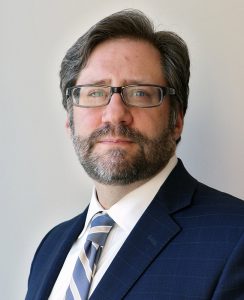 Last week, I had a chance to participate in a conference call with Jon Parrish Peede, the new acting chair of the National Endowment for the Humanities (NEH). He assumes the role after the resignation of William D. Adams in May of 2017, who stepped down concurrent with the release of the White House FY2018 budget that called for eliminating the NEH. The call with Peede was organized by the National Humanities Alliance (NHA), and included leaders of other humanities organizations.
Last week, I had a chance to participate in a conference call with Jon Parrish Peede, the new acting chair of the National Endowment for the Humanities (NEH). He assumes the role after the resignation of William D. Adams in May of 2017, who stepped down concurrent with the release of the White House FY2018 budget that called for eliminating the NEH. The call with Peede was organized by the National Humanities Alliance (NHA), and included leaders of other humanities organizations.
Peede, who was appointed by President Trump in late July, is the brother of a senior member of Vice President Mike Pence’s staff.
During the call, Peede talked about his closeness to Dana Gioia, the George W. Bush-appointed head of the NEA, and proudly referred to himself “a product of rural America,” stressing the need for having people from all 50 states on NEH panels.
When asked about his vision for the NEH, he mentioned that humanities could be funded and supported by other organizations, such as colleges, foundations, and individuals. He offered support for grant selection being “grounded in rigor” and wanted grantees to talk about “outcomes and not activities.”
Peede was asked why the public should care about the NEH and stated that the agency’s role is to preserve records and to place them in context, an important position for a federal agency, but one which does not necessarily address the larger idea of the impact of humanities in society. He did state, “a life in the humanities is a life well lived.” In response to a question about what he would do if the NEH received an increase in funds, Peede was not sure, but opined that he might not offer more grants as it may “dilute the value” of other grants.
Unfortunately, he was not asked how he felt about the President’s desire to zero out funding for the NEH or NEA, and what he was planning to do about it. For many in the arts and humanities, this is the pressing issue. Currently, the NEH is approved by the House Appropriations Committee for $145 million in funding for FY 2018, a $4.8 million drop from FY 2017. But the funding is not secure and certain. Hopefully on our next call, Peede will be able to address this important question.
Hunter O’Hanian
Executive Director
Individual Membership Made Simple at CAA and More Benefits
posted by CAA — Sep 19, 2017
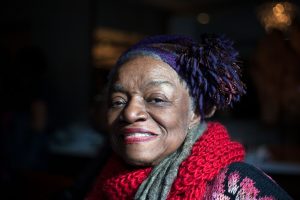
Back in 2014, CAA set aside our old income-based membership system, replacing it with a new system based on the amount of benefits members wanted.
The program was a success, but we discovered that some of the language caused confusion. Starting this fall, we are launching the final refinement of the membership program that will eliminate confusion about the membership levels.
In addition, we will begin rolling out new membership benefits for our 10,000 individual and institutional members.
Understanding that many members face shrinking departmental budgets, for the fourth consecutive year, membership rates will not increase (in fact, we are reducing the student rate). We do this while at the same time planning for one of the largest Annual Conferences ever.
In February 2018 in Los Angeles (February 21-24), we have already scheduled more than 300 sessions and meetings, involving over 1,400 CAA members who will serve as discussants, presenters, and chairs. Additionally, we have secured a seemingly endless schedule of events for CAA members at LA-based cultural and educational institutions, including The Getty Center, The Broad, LACMA, The Skirball Cultural Center, Norton Simon Museum, The Huntington, UCLA, USC, Otis College of Art and Design, Santa Monica College, 18th Street Arts Center, and many, many others.
Registration for the 2018 CAA Annual Conference will open in early October.
New Membership Levels
Starting on October 1, 2017 you will see three individual membership levels on the CAA website membership page and in our membership materials. You can choose a membership level based on where you are in your career and whether you expect to go to the Annual Conference.
Tier One Membership
$195 annually/$380 two years (formerly Premium Membership)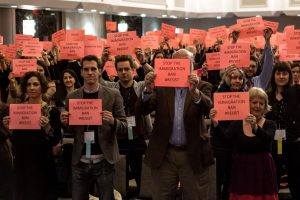
This level is designed for working professionals in the myriad visual arts fields that support the association and expect to attend CAA’s Annual Conference. You will receive a 55% discount on your early Annual Conference registration. You will still receive one of the two flagship CAA publications (Art Journal or The Art Bulletin), along with all other benefits.
Tier Two Membership
$125 annually/$245 two years (formerly Basic Membership)
This level is designed for professionals for whom the Annual Conference is not a priority. Tier Two members get a 20% discount to the Annual Conference and receive one of the two flagship CAA publications (Art Journal or The Art Bulletin), along with all other benefits.
Tier Three Membership
$80 annually/$155 two years (formerly part-time, independent, retired)
Tier Three Student
$50 students annually/$95 students two years
Both Tier Three levels are designed for independent artists, student, designers, scholars, art historians, part time faculty, retired and others working independently, without full-time employment. It has all the same benefits of Tier One Membership, including the 55% early Annual Conference discount. Students will be charged only $50.
You don’t need to do anything right now! Upon joining or renewing you will be asked to choose one of the new levels. All of the Donor Circle membership levels (Sustaining, Patron, and Life) will remain the same.
New Benefits
In case you hadn’t noticed, we’ve tried every way we can to discover what you need from your professional association. We know you want to advance your career, access to exceptional scholarship, networking opportunities and advocacy. Without a doubt, finances remain an issue for many members.
We are happy to announce that starting October 1, 2017 we are able to offer CAA members the following new benefits. Sign into your CAA member account after October 1 to make purchases or view discount codes.
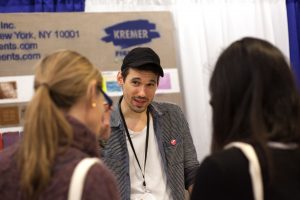
- Lynda.com – The largest online learning network with more than 3,000 courses in design, photography, web development, marketing, and business is now available to CAA members at a significant discount. Members will have access to the full online premium program for $99 annually (regularly $360 annually).
- Legal Services – We have secured the services of a major Maryland/DC law firm, Whiteford, Taylor, and Preston, which works with other Learned Societies, to assist CAA members at a reduced rate ($275/hour). Whether you need help reviewing a book contract, employment agreement, gallery agreement, or fair use legal opinion, as a CAA member, you can now call on a law firm that knows the field.
- Making Fair Use Real – CAA is a leader in the field of fair use of visual images in education and visual arts publishing. We have worked to educate the field and publishers about the permissions that may not be needed for copy written images to support your academic writing. Teaming up with the Whiteford, Taylor, and Preston law firm, we have secured a New York-based insurance agency, C & S Int’l Insurance Brokers Inc., to issue Errors and Omissions insurance policies to protect you and your publisher. It can save you thousands of dollars in permissions for your academic publications.
- Humanities Commons – More than a year ago, we partnered with the MLA (Modern Language Association) to create web-based discussion and resource hubs known as Humanities Commons (public) and CAA Commons (CAA members only). The platforms offer our members the chance to easily share research and resources with scholars in their field and in other fields.
- More Publisher Discounts –It seems we just can’t get away from owning books. We have heard from members that they would like more book discounts. Several publishers/distributers have come forward to offer discounts to CAA members. University of Chicago Press is now offering 20%, Artbook|D.A.P. is offering 25% off online sales, and MIT Press will offer 25% off to members. Sign into your CAA member account on October 1 to view discount codes. More publishers will be announced soon.
- CAA’s Cultural and Academic Network – We know that you rely on the Annual Conference to promote your programs, network in the field, and attract new faculty and program participants. Starting this year at the Los Angeles Annual Conference (February 21–24, 2018), we will completely revamp CAA’s Candidate Center and offer your college or university a better opportunity to promote programs, connect with alumni and colleagues, and to interview prospective faculty members, all at a very affordable price. Say goodbye to the “hotel room” interview!
- An Office in New York City – Many members have told us that when they travel to NYC on business, either to see exhibitions or to conduct interviews, they would like a place to conduct an interview, catch up on email or make a few phones calls. We now have an office for out-of-town members to use at the CAA offices at 50 Broadway.
We are also presently working to secure affordable dental, vision, and health care for our members who presently do not have coverage. We see how difficult the healthcare market is for employees, for employers, and for just about anyone, and we want to do our share to help our members with this challenge. In addition, we are talking to other professional organizations about joint memberships at reduced prices. We hope to have more information to announce later this fall.
All of the other CAA membership benefits remain intact. You will continue to have access to our insightful scholarly publications, such as The Art Bulletin, Art Journal, Art Journal Open, and caareviews. You will still get access to JSTOR, CAA’s online jobs portal, and additional Taylor & Francis publications. Your discounts to art fairs and art magazines and your corporate discounts (car rental, convention hotels, and airfare) will all continue without change. In a new agreement, the International Fine Print Dealers Association will offer our members half-off admission tickets to their Fine Art Print Fair every year. Shortly, newsletter subscribers will also find a new Monday newsletter dropping into their inbox that focuses more on advocacy, jobs, and opportunities. CAA Conversations, our video interview series, will soon grow to include podcasts focusing on issues in the field of visual arts and teaching. Outside of member benefits, the CAA/Getty International Program thrives, as do our Distinguished Awards, publishing grants, and the Professional-Development Fellowship Program. We are, as is often the case, grateful to the Andrew W. Mellon Foundation for the continued support of RAAMP – the program to provide resources to academic art museums. Additionally, we continue to bring the Code of Fair Use in the Visual Arts to academic communities throughout the US and abroad.
We will continue to advocate for the field on the local, national, and international level, never afraid to take a stand on tough issues. We see the budget battle for federal funding for the NEA, NEH, IMLS, and all agencies that support the arts and humanities as a critical to our members. The content in the Annual Conference and in our publications remains exceptionally high. We are at the beginning stages of a rebranding process, which we plan to unveil at the 2018 Annual Conference in Los Angeles. We are working on new standards and guidelines which aid art historians, artists, and designers. We have been doing all of this while we have worked to streamline the administrative staff and keep the association as nimble as possible to meet the needs of the members.
It goes without saying: Your input is important—Keep it coming!
Sincerely,
Hunter O’Hanian,
Executive Director
News from the Art and Academic Worlds
posted by CAA — Sep 13, 2017
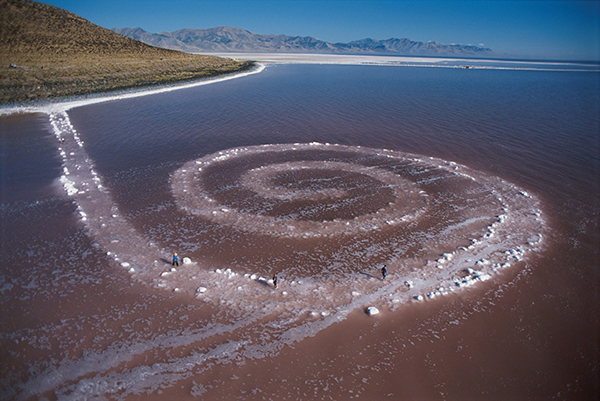
Robert Smithson, Spiral Jetty, 1970. © Holt-Smithson Foundation/Licensed by VAGA, New York. Photo: George Steinmetz
Each week CAA News summarizes eight articles, published around the web, that CAA members may find interesting and useful in their professional and creative lives.
Financial Advice from Arts Professionals for Artists
Christina Empedocles, Sharon Louden, McLean Emenegger, and Wendi Norris share their advice about financial planning, creating budgets, and the importance of the artist fee as self-advocacy.
(Read more from Artsy.)
Rhizome’s Microgrant Awardees Announced
Rhizome announces the winners of this year’s Microgrants in three categories: Net Art, Webrecorder, and IdeasCity.
(Read more from Rhizome.)
The Bruce High Quality Foundation University Closes
Seth Cameron, ex-President of the Bruce High Quality Foundation University, announces the end of the university in “Broken Toilet: The BHQFU is Dead.”
(Read more from The Brooklyn Rail.)
Read John Ashbery’s Reviews from the 50s, 60s, and 70s
In remembrance of the seminal poet and art critic John Ashbery’s recent passing, ARTNews presents excerpts from reviews he wrote while contributor and executive editor to the publication.
(Read more from ArtNews.)
A Stolen de Kooning Painting is Recovered, by the Mystery Remains
Willem de Kooning’s painting Women-Ochre (1955) was stolen from the University of Arizona Museum of Art in 1985. The painting was found in August 2017, but who stole it and why is still a mystery.
(Read more from The New York Times.)
Field Study and Land Art
The Land Arts of the American West program is profiled.
(Read more from Art & Education.)
A Mobile Museum in Vermont
Artist Matt Neckers discusses his mini mobile art museum, the Vermont International Museum of Contemporary Art + Design.
(Read more from the Hyperallergic.)
Universities Issue Statements on DACA
Many universities have issued statements and tweets on the Trump administration’s decision to rescind the Deferred Action for Childhood Arrivals program. (Read more from The Chronicle on Higher Education.)
Deadlines are Approaching for 2017 CAA Professional-Development Fellowships
posted by CAA — Aug 30, 2017
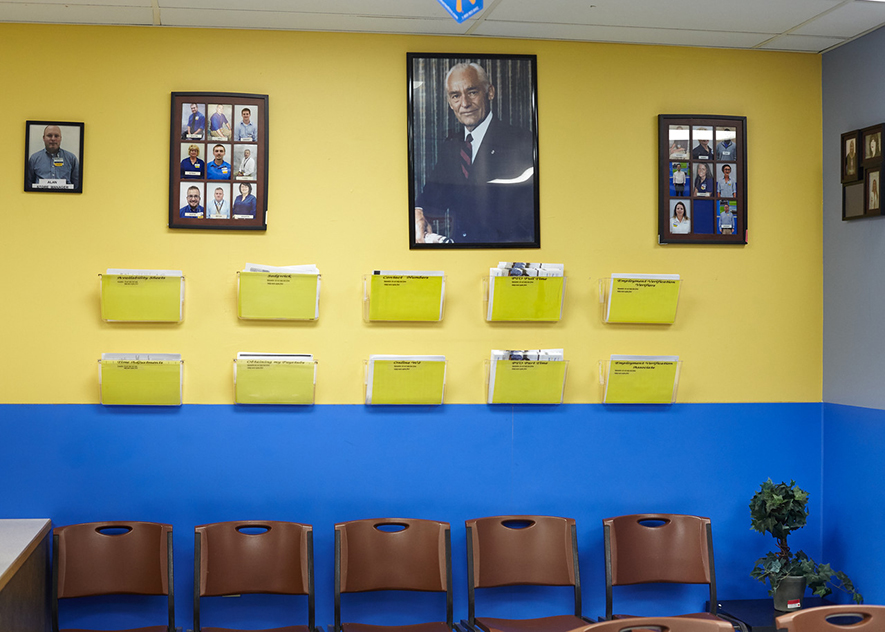
Photography by Daniel Seth Kraus, 2016 Professional-Development Fellowship Awardee
October 2 (PhD candidates) and November 10 (MFA candidates) are the deadlines for the CAA Professional-Development Fellowships. The program supports promising artists, designers, craftspeople, historians, curators, and critics who are enrolled in MFA, PhD, and other terminal-degree programs nationwide.
Fellows are honored with $10,000 grants to support their work, whether it be for job-search expenses or purchasing materials for the studio.
“I remember sitting in my graduate school studio applying for the award. I was day-dreaming about how it could help me be a self-sustaining artist and maybe start my career in teaching. A few months later I received notification of the award and I’m happy to say the grant has helped me enormously with both of my day-dreams, artistic and academic. CAA’s Professional-Development Fellowship for Visual Artists has stabilized a shaky phase of my career and life, continuing an artistic practice after graduate school. The award funds helped me to kick-start my studio space, travel for photography research, and secure teaching positions right out of graduate school. CAA’s support of developing visual artists is certainly outstanding and to an even greater extent, appreciated. I’m happy to now be a CAA member and encourage others to apply for the fellowship without hesitation.” —Daniel Kraus, 2016 Professional-Development Fellowship Recipient
One award will be presented to a practitioner—an artist, designer, and/or craftsperson—and one award will be presented to an art, architecture, and/or design historian, curator, or critic. Fellows also receive a free one-year CAA membership and complimentary registration to the 2018 Annual Conference in Los Angeles, February 21-24. Honorable mentions, given at the discretion of the jury, also earn a free one-year CAA membership and complimentary conference registration.
CAA initiated its fellowship program in 1993 to help student artists and art historians bridge the gap between their graduate studies and professional careers.
CAA Receives NEA Grant for ARTspace
posted by michaelh — Aug 11, 2017

CAA has been awarded a $25,000 Art Works grant from the National Endowment for the Arts to support the next installment of ARTspace, taking place during the 2018 Annual Conference in Los Angeles. Spearheaded by CAA’s Services to Artists Committee, ARTspace is a forum for programming designed by artists for artists that is among the most vital and exciting aspects of the conference. Held at each Annual Conference since 2001, ARTspace is intended to reflect the current state of the visual arts and arts education. The grant is the NEA’s ninth consecutive award to CAA for this event.
ARTspace offers free program sessions and includes diverse activities such as the annual Distinguished Artist Interviews—most recently with Coco Fusco and Katherine Bradford at the Annual Conference in New York last February—and screenings of film, video, and multimedia works in the Media Lounge. Also hosted in ARTspace are live performances and panel discussions that facilitate a conversational yet professional exchange of ideas and practices designed to engage CAA’s artist members as well as the general public.
ARTspace programming for 2017 included sessions on economic fairness and internet activism, artists who collaborate with their families, alternative career paths for artists outside the studio and academia, and a roundtable on artist-run institutions. CAA’s 106th Annual Conference will take place February 21–24, 2018, at the Los Angeles Convention Center and at schools, museums, and other institutions throughout Southern California.
Jane Chu, chairman of the NEA since 2014, has approved over $84 million to fund nearly 1,200 projects and partnerships in all fifty US states in the NEA’s second major funding announcement for fiscal year 2017. The Art Works category focuses on funding the creation of art that meets the highest standards of excellence, public engagement with art, lifelong learning in the arts, and strengthening of communities through the arts. Through grants to thousands of nonprofits each year, the NEA promotes opportunities for people in communities across America to experience the arts and exercise their creativity.
For the full list of 2017 Art Works grants visit the NEA website.


